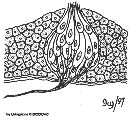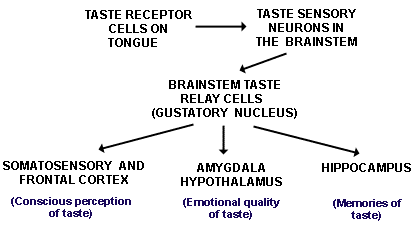| 4. Patterns of nerve activity
encode taste sensations
In other sensory systems, stimulation often activates nerve cells in a
spatial pattern that reflects the body area reporting the sensory input.
For example, a pointed object touching the thumb activates neurons in a
defined patch of the cerebral cortex. When the object touches the pointer
finger, neurons right next to the "thumb cortical neuron" are activated;
that is, neighborhood relationships are maintained from the skin to the
cortex.
But how is taste encoded? How does the brain know that something is
sweet? Here we will consider only taste sensations, and not the
additional flavors that odors add to an eating experience.
Researchers have detected some mapping of tastes is in
higher areas such as the taste or gustatory nucleus in the brainstem,
the thalamus and the cerebral cortex. The mapping appears to be
geographical, as in the touch system-this means that messages from the
tip of the tongue go to different areas in the brain than messages from
the sides of the tongue. Further, some evidence indicates that cells
receiving "sweet" messages in the brainstem may be grouped together, as
are cells receiving salt, sour, and bitter messages.
Researchers have also found that while each receptor responds best to one
type of taste, say sweet, it can also respond weakly to another, perhaps
bitter. This happens because taste cells have more than one type of
membrane receptor, not because bitter compounds are squeezing into sweet
receptor molecular slots. To complicate matters further, a given nerve
axon forms branches in the tongue and sends terminals to several different
taste cells. Thus, it will carry different messages to the brain,
depending on which of its taste cell subjects are reporting to it at the
time. These complicated connections make it likely that neurons in the
brain detect a complex taste, such as sweet-sour, or bittersweet, by a
pattern of activated sensory nerve axons rather than by
an absolute counting of groups of pre-defined sensory and central neurons.
As you might expect, researchers are still trying to sort out this system
and no final answers are at hand. As researchers have found for the
visual and olfactory systems, patterns of axon activation are probably
giving us distinct taste sensations.
5. Sensory processing allows us to interpret
flavors
To summarize how we perceive and interpret flavors, let's follow some food
into your mouth. It's a warm June day and as you drive through the
countryside, you see a roadside stand ahead. Stopping, you buy a flat of
freshly picked strawberries to make jam, but you grab a few to sample. As
you bite into the first one, the tart but sweet juice squishes out and
floods your mouth; escaping molecules waft into your nose and assail your
odor receptors. Many types of molecules are present, and each fits into a
slot on a taste or odor membrane receptor that can accommodate only that
class of molecular structures.
As soon as the molecules stick to their receptors, both ion channels and
second messenger systems go into gear, quickly causing
each stimulated cell to produce an electrical signal. The signals flash
through the axons of taste and olfactory sensory neurons and on to cells
in the brain. The messages zip to several places by way of axons from
secondary or relay neurons. Messages to the limbic system give you that
"aahhh" feeling, others activate memories of previous strawberries, warm
summer days, and steaming pots of bubbling jam. Still other pathways
stimulate motor centers to cause salivation, chewing, and swallowing. The
signals to your frontal cortex activate motor neurons that allow you to
say, "Wow!" and you turn around to buy a second flat of berries.
The experiences of perceiving and interpreting the strawberry flavor are
the result of activating a pattern of neural components, and in turn, a
pattern specific memories, feelings, and thoughts.
6. Genes determine the kinds of taste receptors
that we have, and experiences shape our perceptions
Taste preferences and perceptions vary widely among individuals-we all
know someone who hates bananas, or loves rhubarb, or is unusually fond of
chocolate. Studies have shown that people who are unable to perceive one
type of taste stimulus frequently have small genetic differences from the
general population. Thus, in some cases, foods really do not taste the
same to everyone. In fact, researchers have found that some people are
"supertasters" to whom sweet things taste much sweeter and bitter things
much more bitter than to the average person. These supertasters have more
papillae on their tongues than usual, so they probably have more taste
receptors.
Other differences in taste perception may be temporary. Temporary general
inability to taste foods can result from a cold or certain medicines and
usually is caused by the blocking of olfactory rather than taste
receptors.
(You can test this when you have a bad cold by seeing if you can still
perceive that, for example, strawberries still taste sweet and tart,
although you cannot discern many other qualities that you usually do.)
Experiences as well as genetics influence our food preferences. Anyone
who has become memorably ill after eating a particular food seldom wants
to eat it again, perhaps for years or forever. Animal experiments on this
aversion phenomenon showed that pairing food of a specific flavor with a
mild poison that induced vomiting caused permanent refusal to eat anything
with that flavor. Pairing the poison with an auditory tone, however, did
not result in aversion to the tone, even though the animal became ill this
time as well. Scientists believe the close association of stomach illness
with taste and odor is a survival trait that many animals have evolved.
7. Taste disorders may
be genetic, or may result from illness or injury
Although genetic differences account for some cases of ageusia (the
complete loss of taste), the inability to taste, or other disorders of
taste, most are caused by illnesses or accidents. Other taste disorders
include hypogeusia-diminished taste sensitivity; hypergeusia-heightened
sense of taste; and dysgeusia-distortions in the sense of taste. Small
growths in the nasal cavities (polyps), dental problems, hormonal
disturbances, or sinus infections, as well as common colds, may cause
chemosensory losses. Injury to the head may damage nerve centers or break
axons. Patients who receive radiation therapy for cancers of the head or
neck often develop changes in their senses of taste and smell. Are
these disorders serious? Our sense of taste can warn us that something we
put into our mouths may be spoiled or dangerous. Further, eating is much
more than just "food intake" for humans; it is an important part of our
social lives and a source of pleasure. People should see a doctor if they
realize something is wrong with their sense of taste. |






 [Back to Top]
[Back to Top] Explore before the Class Experiment
Explore before the Class Experiment![[email]](./gif/menue.gif)

